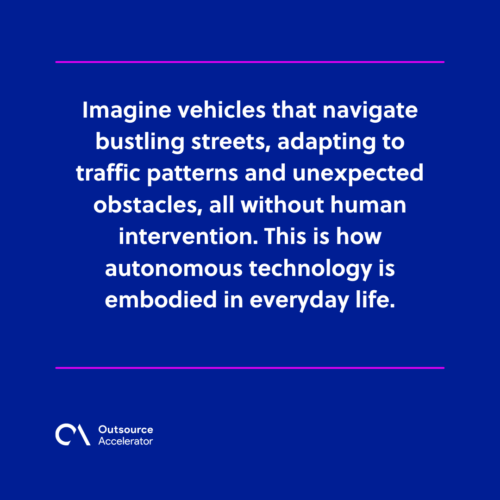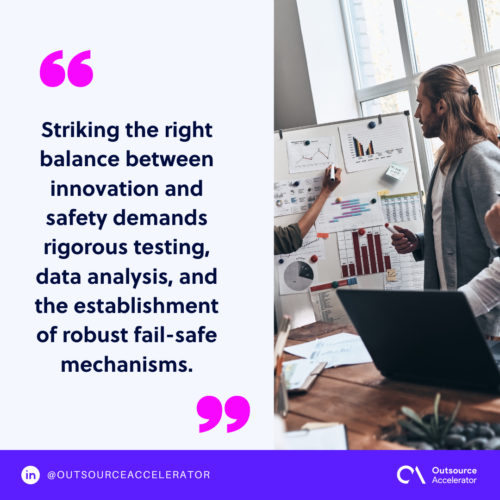Autonomous technology: Pioneering the future of innovation

The concept of autonomous technology has emerged as a trailblazing force in various sectors. It promises to reshape industries and enhance the way we interact with the world around us.
Autonomous technology is more than the dancing robots you have seen online or the robot dogs in sci-fi shows. You might have encountered it in real life through self-driving cars, order-taking systems, automated traffic lights, and other applications.
This article delves deep into autonomous technology, exploring its multifaceted nature, application in various industries, challenges, and possibilities for the future.
Defining autonomous technology
At its core, autonomous technology signifies a monumental leap in the evolution of machines and systems.
Traditional automation involves the execution of pre-programmed tasks. Autonomous technology, on the other hand, empowers machines to make real-time decisions based on their environment.
Fusing artificial intelligence, sensors, and data analytics enables this intelligent autonomy. It employs machine learning aside from computer vision to allow the machine to learn, make predictions, and adjust to the world around it.
Imagine vehicles that navigate bustling streets, adapting to traffic patterns and unexpected obstacles, all without human intervention. This is how autonomous technology is embodied in everyday life.

Autonomous technology takes various forms, including the following.
Robotics and automation
Firstly, robotics and automation refer to using computer and software systems to handle processes and machines.
A cornerstone of autonomous technology, robotics encompasses a spectrum of applications.
The possibilities are limitless, from manufacturing lines used to assemble intricate devices to autonomous drones that survey hazardous environments or deliver packages.
Artificial intelligence
Artificial intelligence (AI) serves as the cognitive powerhouse of autonomous systems. Machine learning algorithms allow AI to learn from vast datasets, recognize patterns, process natural language, and predict outcomes.
Think of virtual personal assistants that understand and respond to your commands or AI-driven recommendation systems that tailor content to your preferences.
Smart systems
Integrating autonomous technology into systems has birthed the era of smart environments. Smart systems combine data processing with sensing, actuating, and communicating functions to execute a process.
A good example is smart homes, where interconnected devices can adjust temperature, lighting, and security settings based on occupants’ habits and preferences.
Categories of autonomous technology
The categories of autonomous technology go the same way with automated vehicles. They usually start with Level 0 — no automation involved, with basic features all handled by humans.
These examples include manual data entry, manual driving, and human-assisted machines in manufacturing.
The rest of the categories are as follows:
Level 1
The foundation of autonomous technology begins with Level 1. This is where rudimentary systems assist humans in performing specific tasks.
In driving systems, this category can manifest in emergency braking and adaptive cruise control.
In other technologies, meanwhile, it can take place in the form of voice assistants, automated processes, and other automation features in a software environment.
This level sets the foundation for our journey into the realm of autonomy.
Level 2
Moving up the ladder, Level 2 autonomy introduces devices capable of managing multiple functions simultaneously.
Here, the system triggers multiple functions while maintaining human involvement to monitor its support. Take, for instance, driving; most cars today are equipped with advanced driving assistance systems (ADAS) that assist in acceleration, braking, and steering.
Level 3
Level 3 marks a significant leap, where technology can perform tasks independently.
However, human intervention may still be required in complex or ambiguous situations, emphasizing the shared decision-making aspect of autonomy. This is to ensure that the machine is guided during these instances.
Level 4
Venturing into high automation, Level 4 heralds devices that can operate independently within well-defined conditions.
Consider self-driving shuttles and trucks navigating predetermined routes in controlled environments. These are already highly programmed to complete the job with minimal human interaction.
Level 5
At the pinnacle of the autonomy hierarchy, Level 5 represents full automation.
Devices operating at this level require no human input for any task in any environment. Think of fully self-driving vehicles seamlessly maneuvering through complex urban scenarios.
Level 6
As a theoretical extension, Level 6 autonomy envisions technology transcending transportation, permeating diverse sectors with AI-driven decision-making and automation.
How autonomous technology is applied in different industries
Beyond automated systems and AI, autonomous technology can be seen in various industries, such as the following examples:
Transportation
The transportation industry stands at the forefront of the autonomous revolution.
Statistics paint a compelling picture of the industry. The World Health Organization stated that over 1.35 million lives are lost yearly due to road accidents. The majority of those involved include pedestrians and cyclists.
Enter autonomous vehicles poised to revolutionize road safety. Companies like Waymo are already designing autonomous vehicles to make roads safe for people and things.
Apart from cars, the skies are also witnessing a revolution in autonomous transportation.
Amazon Prime Air is testing autonomous delivery drones to revolutionize the logistics industry. These drones, designed to navigate through complex airspace autonomously, could significantly expedite the delivery of goods while reducing the carbon footprint.
Agriculture
Autonomous technology is plowing through the agricultural sector, transforming age-old practices.
Per the Food and Agriculture Organization (FAO) statistics, the global population could reach more than 9 billion by 2050. This increase in population requires the world to raise food production by at least 70%.
Robotic farming is revolutionizing every facet of farming. From precision planting to targeted pesticide application, these robots optimize every step of the agricultural process, reducing resource wastage and boosting yields.
Moreover, the benefits extend beyond the fields. Reduced pesticide use, efficient resource management, and optimized land utilization contribute to a more sustainable agricultural ecosystem.
Autonomous technology is heralding a new era where farmers can embrace innovation while nurturing the planet.

Healthcare
Autonomous technology in healthcare is revolutionizing patient care and medical procedures.
Surgical robots, guided by skilled surgeons, offer unparalleled precision and skill during complex surgeries. AI-powered diagnostic tools analyze medical images, aiding doctors in accurate disease detection and treatment planning.
Furthermore, the fusion of autonomous technology with telemedicine breaks geographical barriers.
Robotic telesurgeries are becoming a reality. This ensures that patients in underserved areas receive the same quality of care as those in major medical centers.
Additionally, robots can safely transport medication and supplies within hospitals, minimizing human contact and reducing the risk of infections.
Manufacturing
Autonomous technology is reshaping the manufacturing landscape by enhancing efficiency and precision. Robots equipped with advanced AI algorithms collaborate seamlessly with human workers.
One prime example of this impact is the automotive industry. Assembly lines are now populated by a symphony of robots that weld, paint, and assemble vehicles with remarkable efficiency.
Tesla’s Gigafactory boasts an army of robots that collaborate to produce electric vehicles at an unprecedented scale. It has helped build the company’s self-driving vehicles, with a reportedly new army designed to build the Cybertruck.
Moreover, autonomous technology is redefining the supply chain. Smart warehouses with autonomous robots navigate the aisles, efficiently retrieving items for packaging and shipment.
This reduces human error, optimizes inventory management, and expedites order fulfillment.
Challenges in managing autonomous technology
Despite its advantages, autonomous technology also poses challenges in managing and maintaining these advancements.
Ethical dilemmas
Picture an autonomous vehicle in a life-or-death scenario. It’s a real ethical dilemma that autonomous technology confronts.
The decisions these systems make have profound implications, raising questions about how to infuse AI with a moral compass.
Striking a balance between utilitarian logic and human values remains a formidable challenge.
Safety concerns
Ensuring the safety of autonomous technology is paramount. The intricate dance between technology and the real world is rife with uncertainty. Consider the case of self-driving cars.
While they promise safer roads, accidents involving autonomous vehicles have sparked concerns. Tesla’s self-driving vehicles are on fire for this part, recalling over 300,000 cars due to its misbehavior in intersections and issues with speed limits.
Striking the right balance between innovation and safety demands rigorous testing, data analysis, and the establishment of robust fail-safe mechanisms.

Legal and regulatory hurdles
The rise of autonomous technology has ushered in a legal and regulatory quagmire. Crafting laws encompassing the complexities of autonomous systems is a challenge governments worldwide grapple with.
Fostering innovation and ensuring accountability at the same time requires an agile and forward-thinking approach to legislation.
Job displacement
As automation takes center stage, concerns about job displacement loom large. The World Economic Forum estimates that by 2025, automation could displace 85 million jobs but create 97 million new ones.
The challenge lies in reskilling and upskilling the workforce to ensure a smooth transition.
Technological reliability
Autonomous technology promises unparalleled efficiency. However, the reliance on these systems introduces vulnerabilities.
From technical glitches to cyberattacks, ensuring the reliability of autonomous systems requires constant vigilance and proactive measures.
Utilizing autonomous technology in the future
The trajectory of autonomous technology is poised for a remarkable journey. The potential applications are boundless, from creating intelligent traffic management systems that optimize urban mobility to developing autonomous drones for emergency response.
As AI evolves and technologies synergize, we can envision a future where autonomous technology seamlessly integrates into our lives. In turn, it enriches our experiences and transforms industries.
Autonomous technology represents a paradigm shift in our interaction with machines. Its diverse applications across the transportation, agriculture, healthcare, and manufacturing exemplify its transformative power.
As we embrace the era of autonomous technology, we embark on a path toward a future where innovation knows no bounds.







 Independent
Independent




